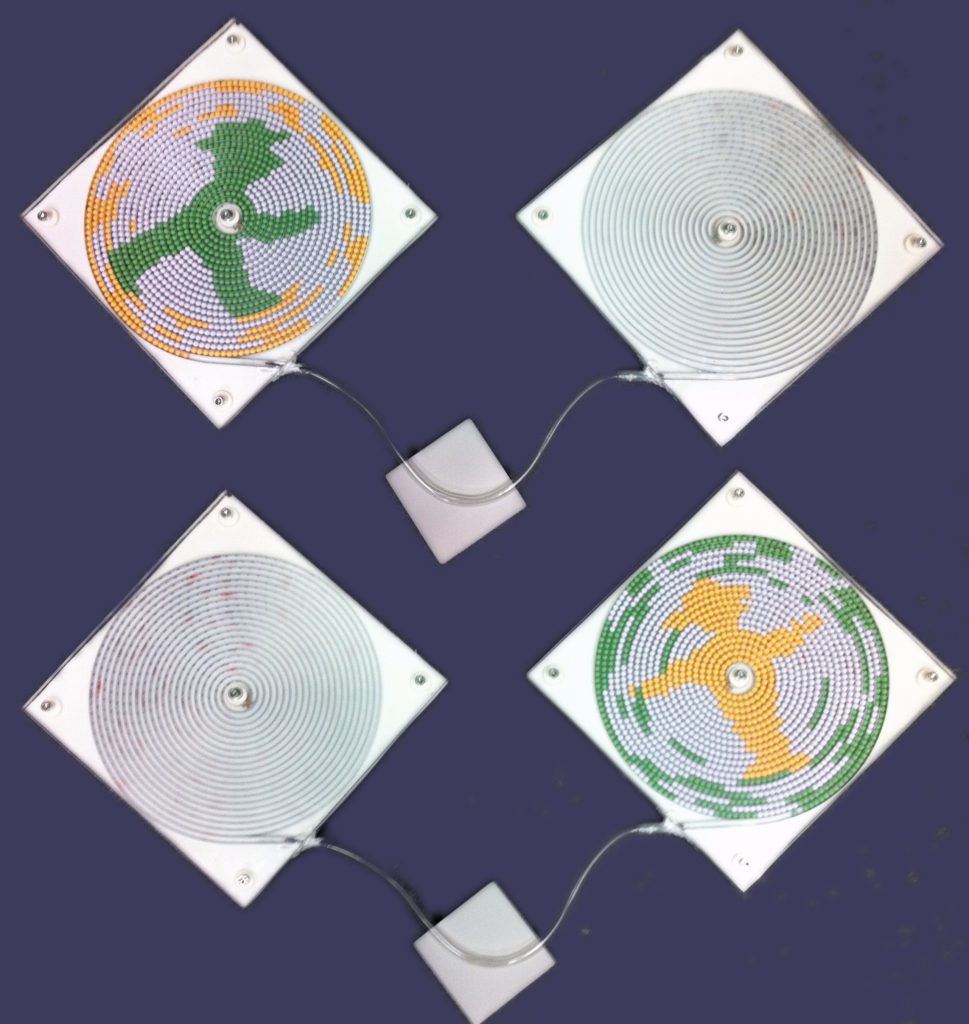Serial Paintings aims at revealing the hidden physical and mathematical relationships between a two-dimensional image and its material support. In “Back and Forth – anadromes pneumatiques“ (A. Cassinelli & Daniel Saakes, 2013), the first work in the series, a string of colored beads is pushed back and forth between two canvases using compressed air. Without rearranging the order of the beads, the sequence is forced to fold and unfold inside spirals, alternatively revealing images with opposite meanings. Each image has to be destroyed in order to create the other. This cyclic process of creation and destruction is purposefully revealed and triggered by the public.
The canvas as a decrypting/encrypting mechanism
The canvas of a traditional painting is a 2d surface supporting colored pigments. Here, the support is instead one-dimensional: a curve filling the surface that guides a strings of colored beads. Faithful to the original meaning of the word, this display “unfold, spread out, unfurl” images (from old French desploiir, modern deployer and from Latin displicare). Without rearranging the order of the colored beads, the string is curled into particular shapes in 2d space resulting in decrypts the sequence as a two-dimensional image.
This is in contrast with ordinary ways of image generation – including displays or printers – that require a mechanism to arbitrarily position a “writing head” in two-dimensional space. It is this “random access” to the surface that render them capable of producing arbitrary images. In a Serial Painting, images are encoded as linear strings of “pixels” constrained in a curvilinear guide. As a consequence, only one coordinate is necessary to address a particular position. Translating the pixels along this coordinate (even by a single step) distorts the entire image by altering the inmediate neighborhood of every bead rendering it unrecognizable or swapping it with another. This is to our advantage: several images can be encoded in the sequence, and while one appears clear, the other ressembles noise.
“Back and Forth: anadrome pneumatique” (in collaboration with Daniel Saakes, 2013) is the first work of the ‘Serial Painting’ series. We see it as ‘serial displays and sculptures’ (2d) that alternatively encrypt and reveal visual information using unidimensional streams of matter. In our first work (2013), two spirals are used as the guiding medium. This allows for a unique (but straightforward) encoding, equivalent to the linguistic anadrome: “spelling” the image backwards (the sequence is reversed when moving from one spiral to another) reveals a new image with a different meaning – perhaps even its opposite.

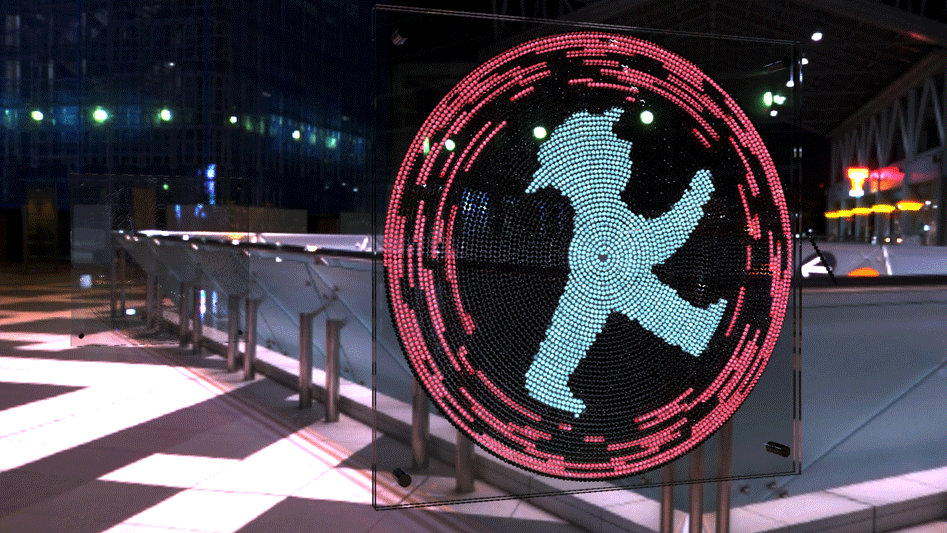
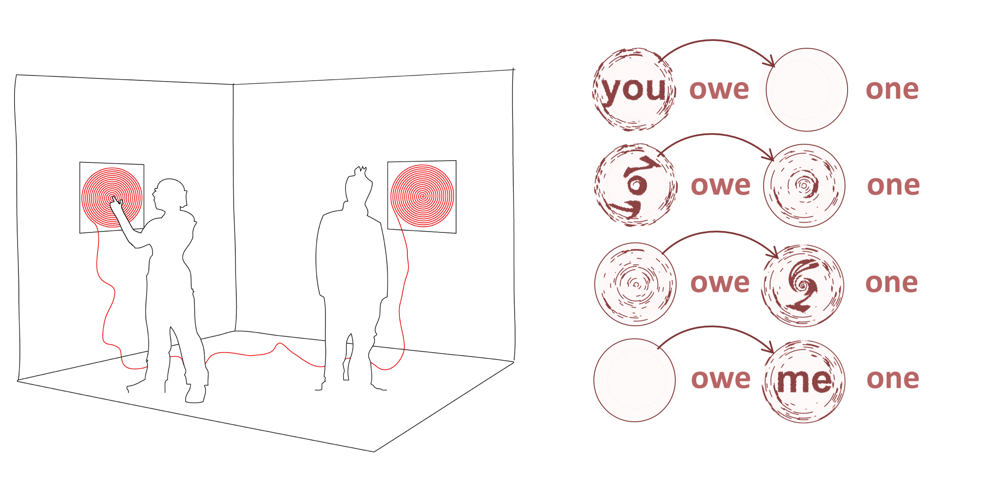

This piece is made out of laser cut acrylic, metallic strip and plastic beads. The canvases are placed far away (either hanging on the wall or attached to the ceiling – Fig.2). Images are “sent” back-and-forth through a long transparent plastic tube. These “pneumatic paintings” are operated by the public using an air compressor. Another possibility is to use a hand pump, requiring an interesting and suggestive form of exertion (both methods are shown in the video). More poetically perhaps, it is possible to directly blow through a hole in the canvas. The breathing from order to chaos and back constitutes an exciting moment of the painting: a swirling (and noisy) visual abstraction representing cycles of creation and destruction of subjectively perceived forms.
Fabrication of the pneumatic/liquid serial display
The air guide has to be air-tight and designed to minimize the distance between beads in adjacent arcs, what we could achieve after several design iterations. The first attempt was to sandwich two CNC cut acrylic plates both with a spiral and half circle cross section. Polishing the cut-out spiral was critical point in manufacturing (rugosities can jam the flow of beads or produce visual artifacts). Grinding square cross-sections were tried in a next iteration but the separation between the spiral arms was too large, thus decreasing the resolution. We finally settled on a laser cutter to create a fine but deep groove on the acrylic plate, and manually inserted a metallic tape approximately 150 microns thick, visible in Fig.4 (right).
Control of the airflow and uniform pressure are critical construction factors in this design, as the acrylic plates tend to bend with air pressure, and the beads may get stuck. Using water instead of air was also explored and we consider it a better alternative for future works in the series. Indeed, water has several advantages: it is incompressible and produces a smooth drag of the beads; it also renders the frame almost transparent because of a relatively similar index of refraction with respect to acrylic or glass. Finally, transparent beads can be used to create spaces between colors, thus permitting modulation of the sunlight if the “painting” is used as a window.
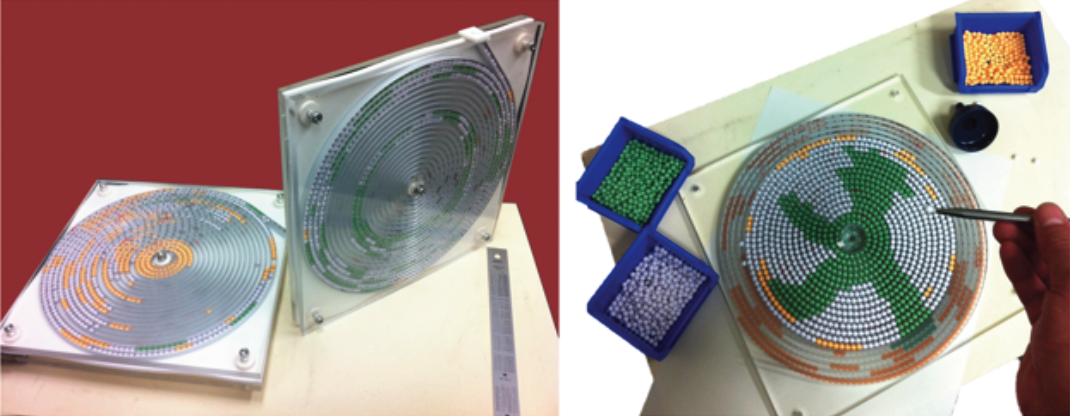
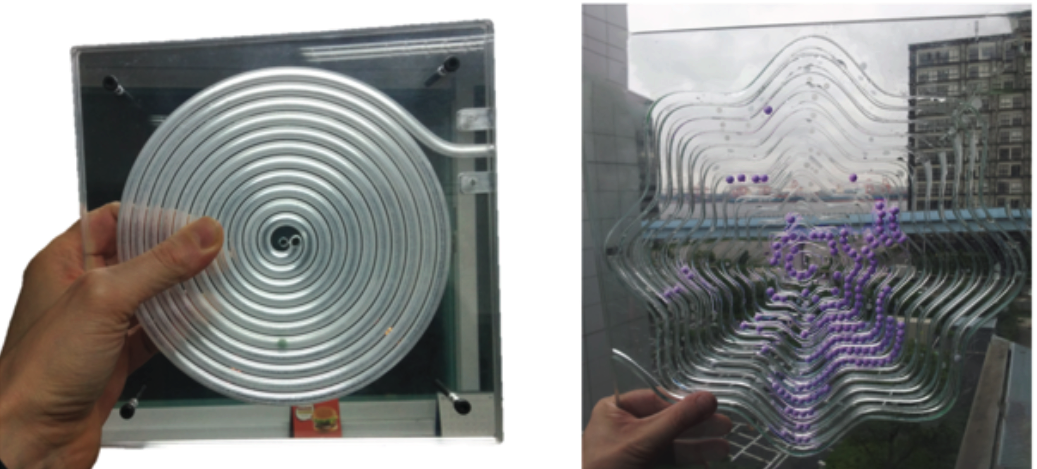
Encoding 2d images on one-dimensional curves
We created two Processing sketches, the first one to produce the desire space-filling curves (the canvas shape), and another to calculate the corresponding sequence from a given image (or by manually painting it – see video below). It is easy to create space-filling curves as fractals [4] determined with a simple set of rules, using an L-system [1]. The software produces SVG files representing several typical fractal curves approaching a fractal dimension equal to two (strictly space-filling) such as the Sierpiński curve, the H-three, the Hilbert curve, or the Gosper curve. We also explored fractals of lower dimension or non-self-similar curves (such as a spirals or a raster scans) roughly covering the surface because of the physical size of the beads. The second sketch takes as input one or more images and help visualize the transformation as they fold/unfold on the canvas in real time. Images can be “injected” (without distortion) at any time in the process, thus becoming entangled with the others. The process is manual (including tweaking some pixels to clear superpositions) but could be automated to obtain more optimal entanglements penalizing crossovers, thus enhancing the perceptual quality of the images (i.e. one image appears clearly while the other resembles background pepper noise).

The position of the colored beads (pre-computed the Processing sketches described above), have been placed manually in a long, patient operation while the spiral is open. A pick-and-place machine could be used to fill the spiral from the top, but we are in the process of designing a mechanical bead selector so as to introduce the beads serially in the guide.
Serial Paintings on space-filling fractal guides
We have explored other one-dimensional guides, such as space-filling fractals. The nature of this type of guide reveal interesting hidden self-similarities in the images. As the pixels circulate in the guide, the images seem to break into pieces to suddenly reappear, but with subtle errors, missing parts, rotations or translations. The phenomena come directly from the self-similar transformation for each fractal. Parts of the image (or the image as a hole) crystallizes and becomes recognizable if it possesses this hidden structure itself. Real images are not mathematical fractals, but they have a certain degree of self-similarity (this observation is behind the fractal lossy compression algorithm [2]).


The simplicity of the “displaying” mechanism enables unlimited scaling as the stream of beads need only one point of entry. Indeed, it should be easy to cover large walls or columns, or even create a slowly evolving dynamic stained-glass window by sandwiching a thin water guide between two transparent frames, and using translucent pieces of acrylic. Miniature systems such as microfluidics displays is another possibility.

Serial Scultpures on volume-filling fractal guides
Interestingly, a fractal curves could fill a volume (check [5] for a beautiful demonstration). Consequently, it would be possible to extend the principles described here to dynamical 3d “Serial Sculptures”. This also points to the interesting technological possibility to develop a serial printer (beads or liquid could fill in a controllable manner and be helped by capillary forces) capable of producing arbitrary images or volumes. To create a final solid volume, the plastic beads could be melted together by heat, and the support dissolved or scratched manually.
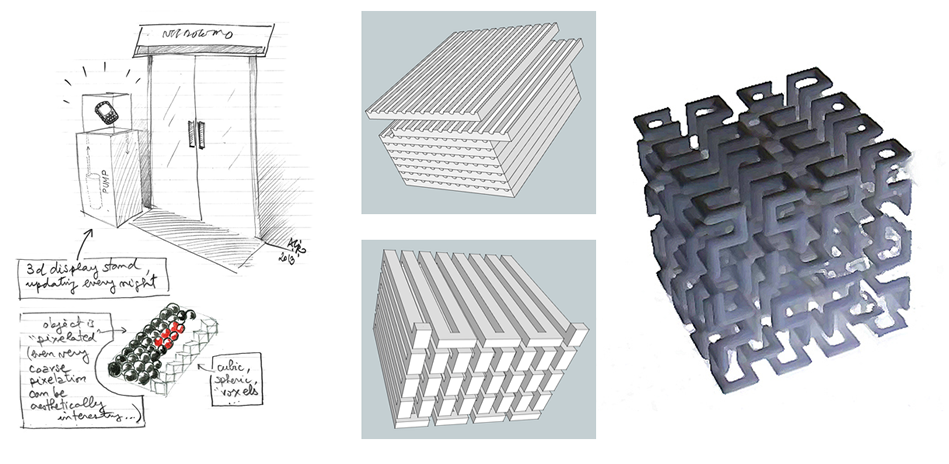
Some references
[1] Grzegorz Rozenberg and Arto Salomaa. The mathematical theory of L systems (Academic Press, New York, 1980)
[2] Yuval Fisher, Fractal Image Compression: Theory and Application, Springer-Verlag New York, 1995.
[3] Kazuhiro Kobayashi et al. Microfluidic-based flexible reflective multicolor display, Microsystems & Nanoengineering (2018).
[4] Mandelbrot, Benoit B.; The Fractal Geometry of Nature. New York: W. H. Freeman and Co., 1982
[5] Steve Mould, Space Filling Curves Filling with Water, 2023 [Youtube]
Publications & Exhibitions
- Cassinelli, A., Sandor, C. & Saakes, D., “Back and Forth – pneumatic anadrome“, ACM SIGGRAPH Asia 2020 Art Gallery, art.7, 8 pages, [4.12.2020].
